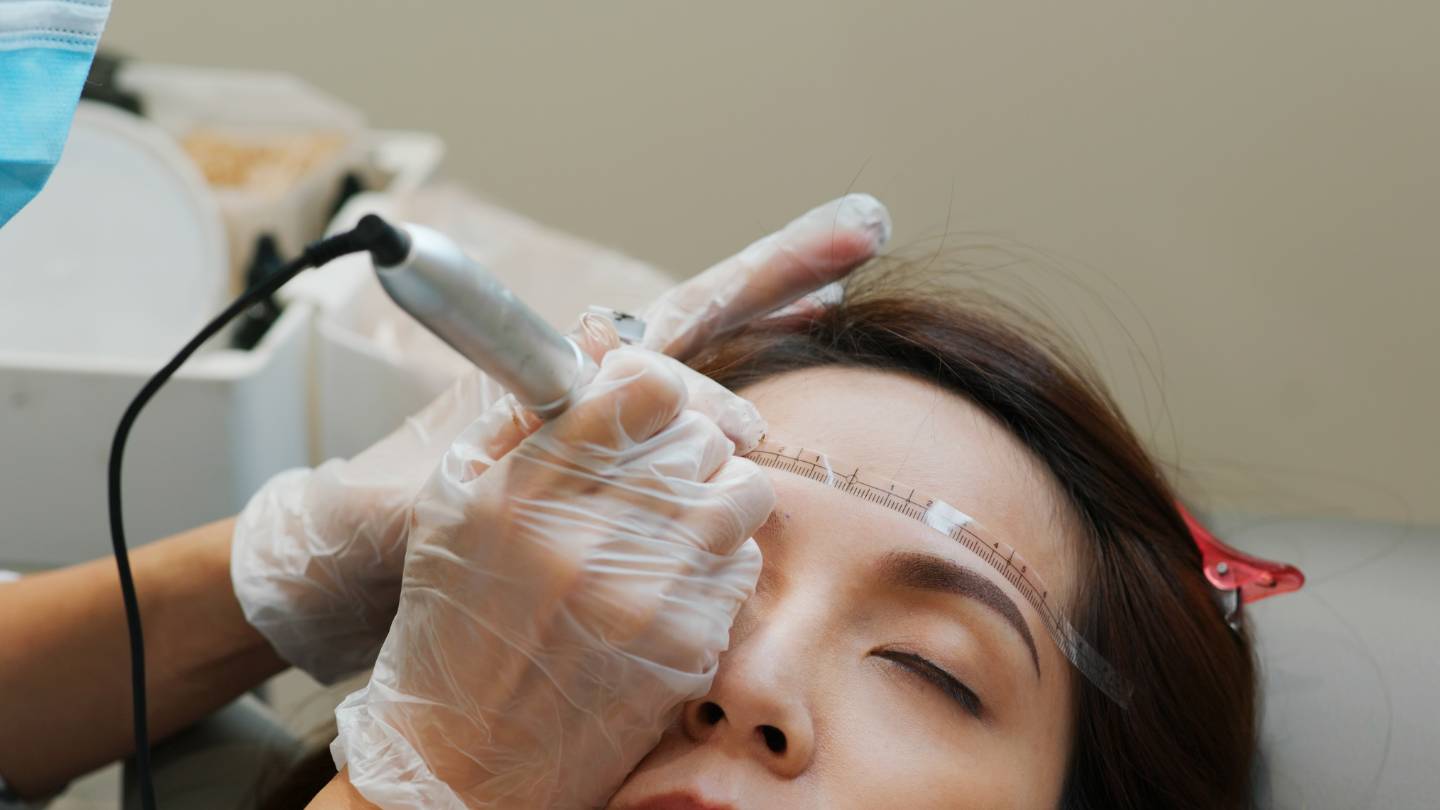Nano-blading and microblading are popular semi-permanent solutions for achieving perfectly shaped, fuller eyebrows. These treatments offer natural-looking brows that save time on daily makeup routines but differ in technique and results.
Microblading, the more established of the two, uses a hand tool to make hair-like strokes by depositing pigment into the skin’s upper layers. This method offers a defined and structured look, making it a great option for individuals with sparse or uneven brows who seek a more uniform appearance.
Nanoblading, on the other hand, is a newer and more precise method that uses a finer, needle-based tool to create ultra-thin hair strokes. This technique allows for even greater detail and a softer, more natural finish than microblading.
Nanoblading is ideal for those looking to enhance their brows subtly or for individuals with sensitive skin, as it is generally less invasive. Ultimately, the choice between nanoblading and microblading depends on your skin type, desired brow style, and how natural or bold you want the final result to appear.
Let’s get straight to the point.
Nanoblading and microblading are semi-permanent eyebrow treatments designed to create fuller, natural-looking brows. Microblading uses a hand tool with multiple tiny needles to create thicker, more defined strokes, making it ideal for people with sparse brows who want a noticeable definition.
Nanoblading, a newer technique, uses a single, ultra-fine needle to produce more precise, thinner strokes for a softer, more natural appearance. This technique suits those with oily skin or seeking subtle enhancements.
While both techniques offer long-lasting results, nano-blading typically lasts up to three years and is less painful with faster healing, whereas microblading lasts about 12–18 months. The best option depends on your skin type and desired brow style—bolder, defined brows (microblading) or delicate, natural ones (nano-blading). A professional consultation is recommended to choose the right method for your needs.
What Is Microblading?
Microblading is a widely used cosmetic procedure that enhances the appearance of eyebrows by depositing pigment into the skin with a fine handheld tool. This tool consists of multiple needles, making tiny, hair-like strokes resembling natural eyebrow hairs.
The technique offers a semi-permanent solution, with results typically lasting one to three years.
The Microblading Process
The microblading journey begins with a consultation. During this initial appointment, you and your artist will discuss the shape, colour, and overall appearance you want to achieve.
The skin must be in good health to proceed with the treatment, and certain medications or Products for skin care may need to be avoided. Beforehand to ensure a smooth procedure.
Once the numbing cream is applied, the artist begins the detailed work of adding pigment to your skin. Each stroke is meticulously crafted to simulate real eyebrow hairs, resulting in a natural-looking brow enhancement.
The procedure typically takes up to two hours, with a follow-up session recommended 6-8 weeks later to adjust and perfect the results.
Healing And Aftercare
Post-treatment care is essential for optimal results. Following the operation, the eyebrows will seem darker than expected but lighten as they heal. You must avoid getting your brows wet.
Don’t use skincare or cosmetic products in the area, and abstain from activities that cause excessive sweating, such as swimming or exercising. Aftercare ointments are usually prescribed to aid healing, and adhering to these instructions will extend the longevity of the microblading effects.
Who Should Consider Microblading?
Microblading is a great option for individuals who want to enhance their eyebrow shape, density, or definition. It’s especially useful for those with thin or sparse brows or anyone looking to reduce the time spent on daily makeup application.
However, oily or overly sensitive skin may experience less durable results. Hence, a consultation with a professional artist is essential to ensure this treatment suits you.
What Is Nanoblading?
Nanoblading is a more recent technique in eyebrow enhancement, offering even finer and more precise results than microblading. This method uses ultra-fine needles to replicate the appearance of individual eyebrow hairs, making it ideal for those seeking a natural yet fuller brow appearance.
The strokes created by nanoblading blend seamlessly with your existing brow hairs for a nearly undetectable enhancement.
The Nanoblading Technique
Nanoblading is performed with a single-needle device, similar to a tattoo machine, but designed for delicate facial skin. The extremely fine needle increases precision, creating thinner strokes resembling real eyebrow hairs.
During the procedure, the needle is dipped in a pigment matched to your skin tone and hair colour, and the artist injects it into the skin to form flawless, natural-looking brows.
Experience And Longevity
Nanoblading is known for being relatively comfortable, with most clients reporting minimal discomfort. The results can last up to three years, depending on your skin type and lifestyle.
Many prefer nanoblading for its longevity and ability to create a soft, natural appearance that looks less defined than microblading.
Best Candidates For Nanoblading
Nanoblading is suitable for individuals with thin eyebrows, persons with alopecia who are losing their hair, or even clients with no eyebrow hair. It is also an excellent option for people with oily skin, as the finer strokes hold up better over time compared to the broader strokes created in microblading.
The technique also allows for detailed modifications of the eyebrow shape and arch, offering a customised treatment based on the client’s facial structure and preferences.
Healing And Aftercare
Like microblading, the healing period for nanoblading takes about 6-8 weeks. The eyebrows go through several stages before settling into the final result, including darkening, scabbing, and peeling.
Proper aftercare, such as avoiding sun exposure, makeup, and excessive sweating, is vital to ensuring the longevity and success of the treatment.
Key Differences Between Nanoblading And Microblading
Technique And Tools
The main difference between nanoblading and microblading is the tools and techniques used. Microblading involves a handheld tool with several closely arranged needles, typically 0.20 mm thick, to create hair-like strokes.
Nanoblading, on the other hand, uses a single, finer needle ranging from 0.15 mm to 0.18 mm, which results in thinner, more precise strokes that closely mimic natural hairs.
Results And Appearance
Microblading generally produces more pronounced, defined brows, making it ideal for individuals looking for noticeable enhancement. The strokes are thicker and create a fuller brow appearance.
Nanoblading, with its finer strokes, offers a softer, more natural look. This technique is often favoured by those seeking subtle improvements to their brow shape and fullness.
Longevity And Skin Suitability
Both nano-blading and microblading are semi-permanent, but their longevity can vary based on skin type and lifestyle. Microblading lasts 12 to 18 months, while nano-blading lasts up to three years.
Nanoblading is particularly suited for those with oily skin, as the finer strokes are more resistant to blurring and fading caused by excess oil production. Microblading is often recommended for individuals with normal to dry skin who want more defined, bold brows.
Pain And Healing Process
Due to the finer needle used, nanoblading is often less painful than microblading. This results in less trauma to the skin, leading to reduced bleeding and faster healing.
Both techniques require a follow-up touch-up session after 4-6 weeks to perfect the brow shape and colour. Both healings involve similar darkening, scabbing, and peeling stages before the final result is visible.
Deciding Between Nanoblading And Microblading
Choosing The Right Technique
The choice between nanoblading and microblading depends on several variables, such as your skin type, the desired outcome, and personal preferences. If you’re after a natural, subtle enhancement with finer strokes, nanoblading might be your better choice.
It’s especially advantageous for people with oily skin or larger pores, as the technique’s precision and longevity cater to these skin types.
On the other hand, if you want a bolder, more defined brow look, microblading could be the ideal solution. It’s especially suitable for people with normal to dry skin, as the thicker strokes created by microblading can provide more noticeable coverage.
Consultation With A Professional
Before committing to either technique, it’s essential to have a thorough consultation with a licensed cosmetic tattoo creator. They will evaluate your face’s features, skin type, and aesthetic goals to recommend the best treatment.
A professional can also guide you through the healing and aftercare process to ensure you achieve long-lasting, beautiful results.
Conclusion
Nanoblading and microblading are both exceptional options for enhancing eyebrows. While adding is a great choice for individuals who want a defined, fuller brow, nanoblading is recognised for its accuracy, creative skills, and ultra-natural results.
Ultimately, your decision should be based on your skin type, lifestyle, and the look you hope to achieve. Whichever method you choose, nanoblading and microblading provide semi-permanent solutions that can last for years, allowing you to wake up daily with flawless brows.
Consulting a skilled professional will ensure you obtain individualised care catering to your particular need, resulting in beautifully sculpted eyebrows that complement your face and style.
Frequently Asked Questions
What Are The Main Differences Between Nanoblading And Microblading?
The primary difference lies in the tools used for each technique. Nanoblading uses a nanoneedle, which is significantly thinner than the blade used in microblading.
This allows for finer, more precise hair-like strokes, making nanoblading ideal for a more natural and detailed look. Microblading, while still offering a natural appearance, creates slightly thicker strokes, which can be better for adding overall volume and shape.
Which Technique Is Better For Sensitive Or Oily Skin?
Nanoblading is often recommended for individuals with sensitive or oily skin types. The finer needle causes less trauma to the skin, which can reduce the risk of irritation.
Additionally, the precise strokes of nanoblading are less likely to blur or spread in oily skin, a concern that can sometimes occur with microblading.
How Long Do The Results Of Each Technique Last?
Both techniques offer semi-permanent results, but their longevity can vary. Microblading typically lasts 18 months to 2 years, depending on factors like skin type, lifestyle, and aftercare.
Nanoblading results can last up to two years, but more frequent touch-ups may be required to maintain a detailed appearance, especially on very oily skin types.
Are Nanoblading And Microblading Painful?
Both procedures involve some discomfort, but pain is subjective and can vary from person to person. To minimise pain, a topical numbing cream is applied before each procedure.
Clients often describe the sensation as light scratching. Nanoblading is considered to be slightly less painful due to the finer needle and less invasive technique.
How Do I Decide Which Technique Is Right For Me?
Choosing between nanoblading and microblading depends on several factors, including your skin type, desired results, and budget. If you’re looking for ultra-fine, detailed hair strokes and have sensitive or oily skin, nanoblading might be the better choice.
If you’re aiming for a more general brow enhancement with added volume, microblading could be more suitable. It’s essential to consult with a professional artist who can assess your brows and recommend the best option based on your specific needs.


